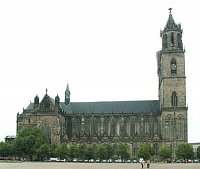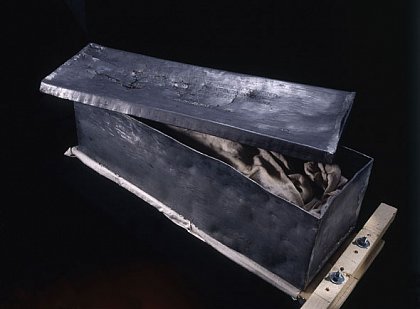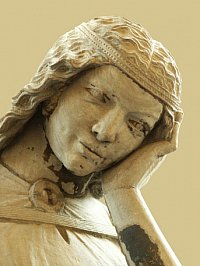Contact
Prof. Dr. Wolfgang Schenkluhn
phone: 0345 55-24310
wolfgang.schenkluhn@kunstge...
Institute for European Art History and Archaeology
06120 Halle (Saale)
Magdeburg Cathedral reveals its secrets
MLU researchers take part in successful excavation process
UTE OLBERTZ
The 800th anniversary of the Magdeburg Cathedral is attracting particular public attention to this unique sacred building in the city on the Elbe River. It survived multiple destructions of Magdeburg and still shapes the silhouette of the city. In October, the international colloquium “The Magdeburg Cathedral in a European Context” attracted renowned scientists from around the world to Magdeburg. Furthermore, important scientific publications emerged as part of the colloquium, some of which will soon come into print. They bear witness to spectacular excavation findings. The Institute for European Art History and Archaeology played a major role in this.

The north side of the Magdeburg Cathedral. Photo: Dr. Heiko Brandl
"The largest church in Germany was completed at the start of the Middle Ages and houses a great number of unimaginable treasures relevant for science," says Prof. Dr. Wolfgang Schenkluhn. Extensive excavations in and around in the cathedral have taken place throughout the year in collaboration with the MLU's Institute for European Art History and Archaeology. Spectacular finds were made that were copiously documented. The archaeological publication "Aufgedeckt II", which is to appear in November in time for the cathedral's anniversary, documents in writing and pictures the excavations that have taken place since 2006 up until the discovery of the coffin with the presumed remains of the mediaeval Queen Editha. A review of the excavation findings and a series of sketches round off the publication.
The volume also includes a DVD containing footage of the dig led by Prof. Dr. Gerhard Lampe from the Institute for Media and Communication Sciences at the MLU. (Clips from this are available online starting in November at www.unimagazin.uni-halle.de).
"The excavations of the late-Romanesque-Gothic cathedral in Magdeburg led by the archaeologist Rainer Kuhn were amazingly successful," explains Schenkluhn. "Findings include extensive antiques, various bishops' tombs and the discovery of the remains of the wall of the cathedral's precursor, which give us insight into the Pre-gothic cathedral."
Based on these findings, scholars can draw conclusions about the layout, date and interior of the Ottonian-Romanesque south church buried under today's cathedral and can possibly even detect earlier buildings on the site.
A nine-member work group led by Schenkluhn accompanied and advised the excavation process. A Research Training Group will be established for a five year period that aims to make a complete scientific evaluation of the dig including the Editha find. The findings so far indicate that it is indeed the remains of Queen Editha, the Office for Heritage Management and Archaeology in Halle disclosed recently. Once the coffin is returned, she too will be moved to another grave in Magdeburg by the end of the year.

The lead coffin of Editha with an inscription on the lid. Photo: © State Office for Heritage Management and Archaeology Saxony-Anhalt, Juraj Lipták
| International Colloquium |
|---|
| “The Magdeburg Cathedral in a European Context” is the motto under which international researchers from various fields discussed their findings in the Kaiser Otto Hall at Magdeburg’s Cultural History Museum from 1 to 4 October. The colloquium included topics about history, architecture, art history, archaeology and the preservation of historical monuments. The Europäische Romanik Zentrum e. V. and the MLU’s Institute for European Art History and Archaeology organised the conference. The State Office for Heritage Management and Archaeology and the Stiftung Dome und Schlösser in Saxony-Anhalt Foundation supported them. The results will be published by the Europäische Romanik Zentrum in a series entitled “More Romano”. |
CATHEDRAL INVENTORY
The cathedral was founded by Emperor Otto the Great and replaced by an entirely new building after a fire destroyed it in 1207. The architecture and sculptures of this new structure impressively document the transition into Gothic. Archbishop Dietrich dedicated the cathedral in 1363 and the two towers on the west façade were presented by Cardinal Albrecht from Brandenburg in 1520. This marked the end of three-hundred-year-long construction period.
"Despite many attempts, the cathedral's inventory remained a desire of research," says Schenkluhn. The Magdeburg Cathedral remains the only former archiepiscopal cathedral of the Middle Ages in Germany without an inventory. "A scientifically substantiated inventory, however, is an important requirement for getting the Magdeburg Cathedral on the UNESCO World Heritage list, something which the state is working towards," adds Schenkluhn. The Stiftung Dome und Schlösser in Sachsen-Anhalt Foundation, the State Office for Heritage Management and Archaeology and the Institute for European Art History and Archaeology at the MLU signed a cooperation agreement in January 2005 that aims to present the public with a large inventory of the Magdeburg Cathedral as part of the cathedral's 800 anniversary celebration in 2009.

Prudent virgin. Photo: Dr. Heiko Brandl
Under Schenkluhn's direction, the project "Inventory of the Magdeburg Cathedral 2005-2009", financed through third-party funds, was established at the Institute for Art History. Dr. Heiko Brandl and Dr. Christian Forster are overseeing the project. This extensive work is set to be published by the end of the year. The comprehensive and richly-illustrated work contains around 800 pages and is eagerly awaited by the scientific community. The list of inventory describes the interior and architecture of the cathedral. It comprises more than 1,000 individual projects and includes the famous virgins, 50 to 60 sculptures, multi-storey epitaphs, three organs, eight bells, the crypt, flooring, 18 alters and around 150 tomb slabs in the covered walkways and courtyard.
"The publication is set up along the lines of traditional comprehensive inventories, however it will extend beyond this in certain aspects," explains Dr. Brandl. It should not only serve as architectural reference material, but rather also as a monograph of historical monuments which analyses the facts presented therein and extensively deals with the existing state of knowledge in a scientific manner. "This also includes a detailed analysis, historical categorisation and appraisal of each object," says Brandl.
On top of the current archaeological excavations taking place under the direction of Rainer Kuhn in and around the cathedral, there is as a professional exchange of information within the context of the research group. However they are not a component of the inventory project. Above all there is a certain allure to the new finds as part of the Magdeburg Cathedral as a whole. This means correlations can be made which have heretofore gone unnoticed.
| “Dawn of Gothic” |
|---|
| The exhibit “Dawn of Gothic – The Magdeburg Cathedral and the late Stauffen Period” is on at the Cultural History Museum in Magdeburg until 6 December 2009 with scholarly talks and presentations on the excavations carried out at the cathedral between 2005 and 2009. The sarcophagus of Editha will also be on display as part of the exhibit. |



